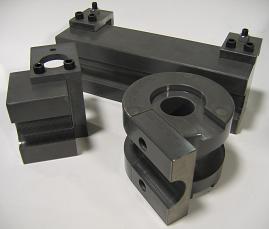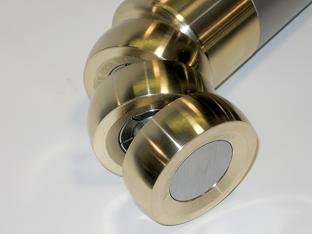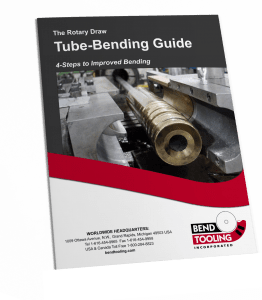by Bill Tingley, Vice President & General Manager, Bend Tooling Inc.
Over the past half-century a lot of ideas have come and gone as to the best materials for rotary-draw tube-bending tools. This is not surprising because of the great advances in materials, heat treatments, and coatings during this period. What may be surprising is that the materials which were the right stuff at the middle of the 20th century remain, for the most part, the best choices for tooling materials at the beginning of the 21st century.
Before further discussion, we should define what “best” means. The best material for a tube-bending tool is that which is most cost-effective. This means more than the ratio of tool life to tool cost, usually expressed as the per-bend cost of a tool. Cost-effectiveness must take into account process control — i.e., stability in a tube-bending machine’s operation that optimizes productivity. In terms of tool life, this translates into exhausting that life through wear rather than failure. This is because, tool failure often causes a process failure, which in turn can shut down a tube-bending machine and reduce its hours of operation.
So cost-effective tube-bending tools should tend to wear out and not break at the end of their life. To bring about this outcome, the tooling set-up on a machine is the most important factor. (For a proven standardized set-up procedure, please see “The Four-Step Set-Up” article.) Next is the tooling material. The full tool kit for a rotary-draw tube-bending machine includes a die set, a mandrel, and a wiper. Each of these have different material requirements, which we will now examine one by one.
Die Sets
A rotary-draw die set has three components: Bend die, clamp die, and pressure die. The key material requirement for these dies is that they are tough. A tough die has hard working surfaces that can absorb a shock without breaking. So a tough die has some give. It is not brittle. For the same reason we do not use glass hammers, we should avoid materials and heat treatments for bending dies that make them brittle instead of tough and so break instead of wear out.
Consequently, the tool steels that are sometimes specified for rotary-draw die sets, such as A2, D2, or even a shock-resistant material like S7, are not the best materials in terms of cost-effectiveness. While they can be heat treated to a high level of hardness, they are designed to hold a sharp edge in metal-cutting operations. So the brittleness that comes with this hardness is acceptable for that use. However, tube-bending is, of course, not a metal-cutting process. There is no need for tooling materials that hold a sharp edge.
There is a need for the durability of work surfaces, specifically the tube cavities of the bending dies, which brittleness degrades. This is why die sets made of tool steel must be drawn back (i.e., softened) during heat treatment to eliminate their inherent brittleness — but also their superior hardness. Therefore, the extra cost of tool steel as a material for die sets does not deliver the maximal hardness that is the rationale for it.
For almost all tube-bending jobs, the best choice of material is an alloy steel that can be heat treated to a high level hardness without inducing brittleness and then can be cased without significant dimensional distortion to further harden the working surfaces of the die set. Nitriding and carburizing are effective methods of casing to make die sets tough. This is why heat-treated alloy steels are used for NASCAR engine components. They are durable and shock-absorbent, whereas tool steel parts would catastrophically fail under the stress of a NASCAR competition. Likewise heat-treated alloy steel bending dies will tend to wear out over a long life rather than fail from breakage.

Mandrels
Since the introduction of the modern ball mandrel in the 1950’s, aluminum-bronze and hard-chrome plated steel have been the most common material specifications. The former has been preferred for ferrous and titanium tubing while the latter for aluminum, copper-based, and, in some cases, mild steel tubing. Even with the advent of remarkable life-extending thermal diffusion and titanium coatings, there remain good reasons for preferring aluminum-bronze and hard-chromed plated steel for mandrel tooling.
For example, the primary cause of shortened mandrel life is not the material specification but set-up. The purpose of the mandrel is to maintain the original round, square, rectangular, or other shape of the tubing throughout the arc of the bend. This is achieved by setting the mandrel so that its nose supports the point of bend, at which the tubing material becomes plastic as it is drawn into a bend. Too often the mandrel nose is set behind the point of bend so that the weaker balls and links must do the work of the nose, which significantly shortens the life of these components.
To offset this defective set-up, frequently a coated tool steel is specified for the mandrel to make the balls last longer. This typically works, although at the unnecessary extra cost of expensive materials and surface treatments and at a significantly increased risk of the tool breaking rather than wearing out. Therefore, if the mandrel is set up as designed with the nose advanced into the point of bend, then the proven aluminum-bronze and hard-chrome plated steel material specifications remain the most cost-effective for almost all tube-bending applications.
Some of the dissatisfaction with these well-established materials arises from the use of improper grades. It is important that the aluminum-bronze specified for a mandrel is alloyed with nickel, which can double the life of the tool over non-nickel grades. (This is not always possible for large-diameter and non-round mandrels for which nickel aluminum-bronze is not readily available.) Similarly, be sure that a hard-chrome plated steel mandrel is made of a through-hardened alloy steel and not a case-hardened low-carbon steel. Also, the plating must be an industrial hard chrome and not a build-up of decorative chrome, which will quickly chip and flake off.

Wipers
Like mandrels, aluminum-bronze and steel have been the most common material specifications for wipers. Aluminum-bronze is best for ferrous and titanium tubing, and steel for non-ferrous tubing. Unlike mandrels, softer grades of these materials are preferred so that the finely tapered feathered edge of the wiper does not prematurely break because of brittleness. Generally aluminum-bronze and unhardened steels have been preferred for wipers, and they remain the most cost-effective materials today. The most significant exception to this involves the bending of aluminized and galvanized steel tubing. To mitigate the build-up of debris from these coatings on the bore of the wiper, often a hard-chrome plated alloy steel is a good alternative to heavy lubrication or routine manual brushing of a soft bronze or steel wiper.
As with mandrels, the most important factor in extending wiper tool life is set-up, not material specification. The key is whether the wiper can be raked or must be set at zero-rake. Raking the wiper usually lengthens its life, because less of the wiper bore is used to prevent the terminal hump from forming at the end of the bend. However, raking is not always possible. Some rigid materials, like many stainless steels and hard coppers, require full containment of the tube at the point of bend and so the wiper must be set at zero-rake. If so, this necessitates a design change in the wiper, namely an offset-geometry feathered edge. (For more details, please see “The Wiper Feathered Edge: The Large Impact of Small Things” article.)
If these considerations for wiper set-up and design are kept in mind, then the conventional material specifications for wipers will continue to prove cost-effective.

Conclusion
What worked well fifty years ago as materials for tube-bending tools continues to work well today. Most of the perceived need for other solutions stems from overcoming problems in the set-up of tooling that causes excessive wear because the tools are not being used as designed. Typically these solutions, such as tool steels for die sets and titanium coatings for mandrels, are borrowed from the metal-cutting industry.
Consequently these materials and coatings have been formulated to keep sharp edges, a quality not needed for tube-bending tools. Therefore, the toughness that is needed in tube-bending tools is compromised with the brittleness that is inherent in metal-cutting materials. Because of this mismatch between materials and function, their extra expense usually does not translate into greater cost-effectiveness over aluminum-bronze, alloy steel, and conventional heat treatments.
While there is a place in tube-bending tools for new materials, heat treatments, and coatings — plastics in particular — attention to sound tooling set-up and design will make the old standbys the best choice for almost all tube-bending applications.

